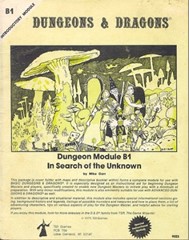 B1: In Search of the Unknown was written in 1978. This makes it one of the earliest adventures for Dungeons & Dragons. Mike Carr was the author, and the adventure was included in the first printings of the Basic Dungeons & Dragons game. Later on, it was replaced in that boxed set by Keep on the Borderlands, but it was still available as a stand-alone product. In Search of the Unknown is the only Basic D&D adventure ever to be printed with a monochrome cover, although the later printings gave it a colour cover.
B1: In Search of the Unknown was written in 1978. This makes it one of the earliest adventures for Dungeons & Dragons. Mike Carr was the author, and the adventure was included in the first printings of the Basic Dungeons & Dragons game. Later on, it was replaced in that boxed set by Keep on the Borderlands, but it was still available as a stand-alone product. In Search of the Unknown is the only Basic D&D adventure ever to be printed with a monochrome cover, although the later printings gave it a colour cover.
The adventure is quite unusual. 1978 was the very first year that TSR produced adventure products for D&D, and there were only six published in 1978 (and only three came out in 1979), so there wasn’t a lot of previous work to be guided by. Mike Carr decided to fully detail the setting of the adventure, but left placement of monsters and treasure mainly up to the individual DM. He gave a list of sample enemies and treasures, and there are a lot of blank spaces in the adventure for the DM to write in the contents.
The premise of the adventure, such that it is, is simple: Two famous adventurers built a base of operations where they stored the possessions they’d acquired during their adventuring days. Both have been reported to have perished a few years ago in the barbarian lands. Now, brave adventurers (the player characters) can enter their lair to discover what treasures they left behind!
The first four pages of the 32-page adventure booklet give advice on being a Dungeon Master; then we get 2 pages of background and rumours about the dungeon. After that, the dungeon descriptions begin.
The Caverns of Quasqueton are divided into two levels. The upper level contains the living quarters of the two adventurers: a total of 37 encounter areas over 13 pages. The descriptions of each of the areas are quite verbose and are definitely a highlight of the adventure. Interestingly, there is a Wandering Monsters table included.
The map doesn’t always make the most sense. It seems that the builders of the complex wanted to confuse anyone who entered the place rather than making it a good place to live. For instance, the recreation room can only be accessed by traversing a maze! The maze contains one of those tricks that delighted the early D&D designers: a set of stairs that stay on the same level, but that fool explorers into believing they’re going deeper into the dungeon. (The passages around are gently sloped; you can continue to circle “deeper and deeper” if you don’t pay attention).
As a DM, I find this intensely amusing – especially when it caught the group I was running through the adventure. As part of living quarters… it doesn’t make all that much sense, especially not for where it is located.
There are some wonderful areas described here: a Wizard Workroom, a storeroom with many casks and barrels to investigate, and the “Room of Pools” which contains 14 different pools of various magical sorts: acid, healing, wine, green slime…
The lower level of the dungeon is not described in as much detail. It contains a number of rough caverns, which are difficult to map. Three pages contain 19 encounter areas, some of which are described entirely as “CAVERN” and nothing more. Most of the space is given to the Grand Cavern of the Bats and the Cavern of the Mystical Stone, the latter of which has a stone that has 20 random effects, which could cause the increasing or decreasing ability scores, causing a PC to go blind, or healing all damage suffered by a character.
The final part of the adventure gives the lists of monsters and treasures the DM can use to stock the dungeon, as well as listing 48 pre-generated characters to use either as PCs or NPC hirelings of the adventurers.
There’s not really much story in this adventure. It is very much of the exploration variety: here’s a strange environment, go explore it. If there are monsters guarding the treasure, they must be overcome to take it; they’re not actually threatening anyone but looters. Of course, more of a plot could be added, but this was designed for new DMs, who are most likely to use it as written.
The most interesting part of the product is the notes for new DMs. They give insight into the D&D of the time: exploration-based, background to keep players interested, and with men-at-arms and hirelings an important part of the experience.
I like In Search of the Unknown for what it is: a training module for dungeon design and exploration. Some of the areas are quite interesting, but the adventure falls flat due to its “do it yourself” construction. There’s no great enemy to fight, no great treasure to find. For me, The Keep on the Borderlands is an altogether more satisfying module.

I loved running this mission. Depending on the level of creatures and traps with little prep I could run any level characters in it. With nothing to compare it to – it was a perfect battleground for imagination.